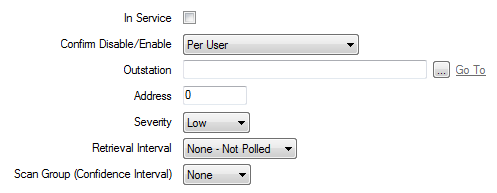Use the fields at the top of the <Point Type> tab to configure the common point properties.
The following fields are common to most points on SCADAPack controllers. For fields that are not described here, see the relevant point configuration section within this guide.

- In Service—Use to specify whether a point is active or inactive (see Placing an Item In Service in the ClearSCADA Guide to Core Configuration).
- Confirm Disable/Enable—Users with the required permissions can disable a point that is In Service, or enable a point that is not In Service. Such actions are carried out using the Disable Point and Enable Point pick actions.
Use the Confirm Disable/Enable combo box to specify whether a confirmation dialog box is displayed whenever an operator requests that this point is disabled or enabled (see Requesting Confirmation of Action Requests in the ClearSCADA Guide to Core Configuration).
- Outstation—Use to specify the controller on which a point is located. Use the browse button to display a Reference browse window and select the relevant controller from the window.
- Address—Use to specify the point’s address. Ensure that you specify the address in the format and range that is supported by the controller on which the point is located . Current SCADAPack controllers use 5 Digit addressing.
For a table of acceptable address ranges for each point type, see SCADAPack Point Addressing.
- Severity—Use this combo box to define the severity of point status alarms. For more information on severities, see Defining Severities in the ClearSCADA Guide to Core Configuration.
- Retrieval Interval—Use this combo box to determine how often the server polls the controller to retrieve the point's current data.
- None - Not Polled—The server does not poll the controller for the point's current data.
- Interval 1 to Interval 8—The server polls the controller for the point's current data at timed intervals. The actual frequency of the selected interval is configured on the corresponding SCADAPack Outstation Form (see Define the Data Retrieval Intervals in the ClearSCADA Guide to the Advanced Modbus Driver).
- Continuous—The server constantly polls the controller for the point's current data.
The Retrieval Interval defines the polling frequency between ClearSCADA and the controller on which the point is located. If Persistence is used, any point state changes will be delayed until the specified persistence time has expired. If the point is configured to use Significant Change, any change in point value will only be recorded if the change exceeds the Significant Change deadband. For more information on both of these properties, see Use Persistence to Stop Fleeting Changes in Value from Changing a Point State in the ClearSCADA Guide to the Advanced Modbus Driver.
The Retrieval Interval combo box on ‘standard’ points is ‘grayed out’ and unavailable for use if the server only retrieves logged, but not current data for that point. (This occurs when the point’s DLOG Only check box is selected—see Log Point Data on SCADAPack Controllers.)
Be aware that the Retrieval Interval field does not apply to some point types supported by the SCADAPack Modbus RealFLO Extension Driver.
- Scan Group (Confidence Interval)—Use the combo box to specify the Scan Group with which the point is associated. The Scan Group determines the frequency with which the driver updates the server with the current value for the point. This provides confidence that all is well between ClearSCADA and the direct controller, as the point is updated in the database at the Scan Group rate, regardless of whether the point has changed in the controller.
With most types of point on the SCADAPack Modbus driver, the specified Scan Group triggers a poll for data at the corresponding Scan Group interval. You therefore typically assign a Scan Group that has an interval that is a multiple of the point’s Retrieval Interval rate. Be aware that if a Scan Group is specified that has a faster interval than the Retrieval Interval, polling will occur at the Scan Group rate (however, this is not recommended).
For any type of point on the SCADAPack Modbus driver, specify the frequency of each Scan Group on the Scan Parameters tab of the associated Channel Form (see Define Intervals for Timed Current Data Updates in the ClearSCADA Guide to Advanced Drivers).
The Scan Group (Confidence Interval) combo box does not apply if the server only retrieves logged, but not current data for a point. (This occurs when a point’s DLOG Only check box is selected—see Log Point Data on SCADAPack Controllers.)
NOTE: The polling of some point types that are supported by the SCADAPack Modbus RealFLO Extension Driver differs from that mentioned above. Where the polling regime differs, the difference is explained in the SCADAPack Modbus RealFLO Driver Guide.